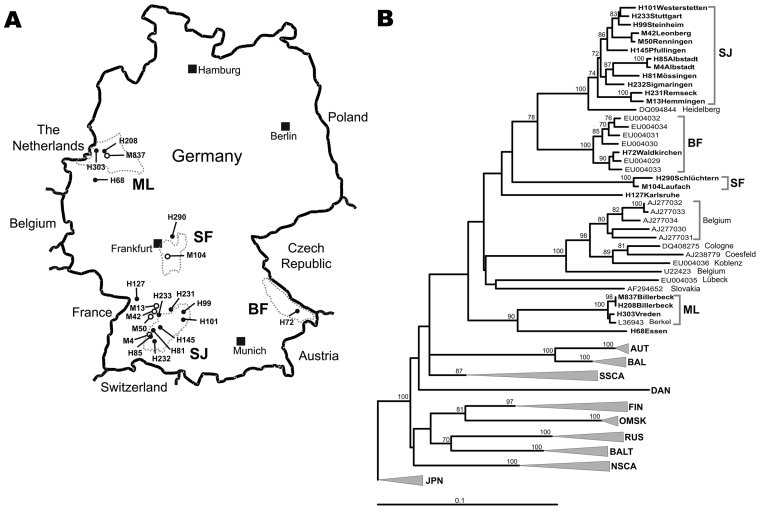Figure.
A) Map of Germany showing origins of viral sequences from the 2007 outbreak. H, sequences of human origin; M, sequences of rodent origin (Myodes glareolus). Dotted circles mark the outbreak regions characterized by particular virus sequence clusters; SJ, Swabian Jura; BF, Bavarian Forest; SF, Spessart Forest; ML, Munsterland. B) Neighbor-joining phylogenetic tree (TN93 evolutionary model) of European Puumala virus (PUUV) strains based on partial sequences of the S segment (557 nt, position 385–941). Bootstrap values >70%, calculated from 10,000 replicates, are shown at the tree branches. PUUV-like sequences from Japan (JPN) were used as an outgroup. Sequences taken from GenBank are indicated by their accession numbers. New sequences from this study are given in boldface. Accession numbers of new sequences are H101, EU266757; H233, EU266758; H99, EU266759; M42, EU085563; M50, EU085565 ; H145, EU266760; H85, EU266761; M4, EU266762; H81, EU266763; H232, EU266764; H231, EU266765; M13, EU085558; H72, EU266766; H290, EU266767; M104, EU246963; H127, EU266768; M837, EU266769; H208, EU266770; H303, EU266771; H68, EU266772. For clarity, previously characterized PUUV clades from other parts of Europe are shown in simplified form. However, the complete dataset of PUUV sequences as presented by Schilling et al. (6) was used to calculate the tree. Previously defined lineages are indicated by abbreviated names: AUT, Austrian; BAL, Balkan; BALT, Baltic; DAN, Danish; FIN, Finnish; NSCA, North Scandinavian; OMSK, Russian from Omsk region; RUS, Russian; SSCA, South Scandinavian. Scale bar indicates an evolutionary distance of 0.1 substitutions per position.

